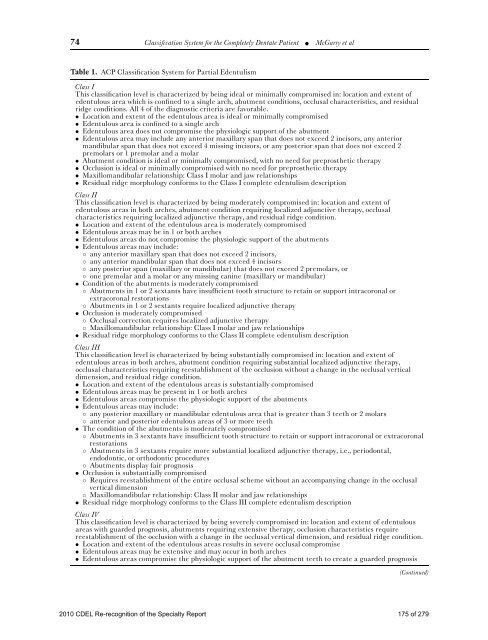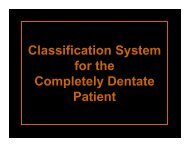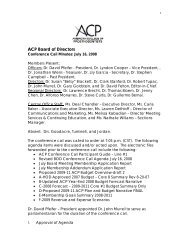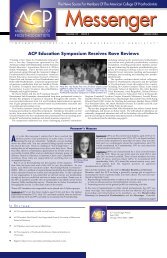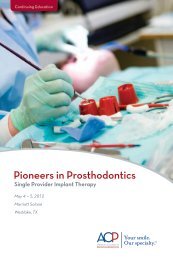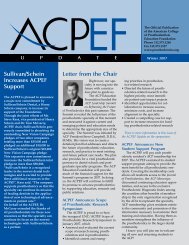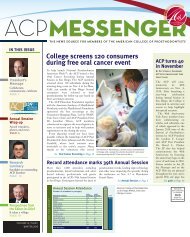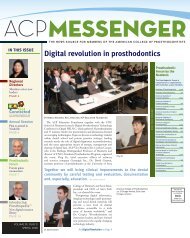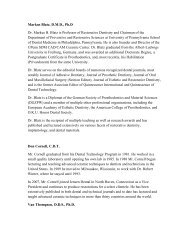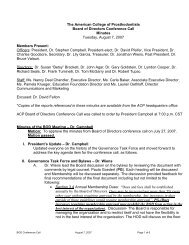PROSTHODONTICS - American College of Prosthodontists
PROSTHODONTICS - American College of Prosthodontists
PROSTHODONTICS - American College of Prosthodontists
You also want an ePaper? Increase the reach of your titles
YUMPU automatically turns print PDFs into web optimized ePapers that Google loves.
74 Classification System for the Completely Dentate Patient McGarry et alTable 1. ACP Classification System for Partial EdentulismClass IThis classification level is characterized by being ideal or minimally compromised in: location and extent <strong>of</strong>edentulous area which is confined to a single arch, abutment conditions, occlusal characteristics, and residualridge conditions. All 4 <strong>of</strong> the diagnostic criteria are favorable.• Location and extent <strong>of</strong> the edentulous area is ideal or minimally compromised• Edentulous area is confined to a single arch• Edentulous area does not compromise the physiologic support <strong>of</strong> the abutment• Edentulous area may include any anterior maxillary span that does not exceed 2 incisors, any anteriormandibular span that does not exceed 4 missing incisors, or any posterior span that does not exceed 2premolars or 1 premolar and a molar• Abutment condition is ideal or minimally compromised, with no need for preprosthetic therapy• Occlusion is ideal or minimally compromised with no need for preprosthetic therapy• Maxillomandibular relationship: Class I molar and jaw relationships• Residual ridge morphology conforms to the Class I complete edentulism descriptionClass IIThis classification level is characterized by being moderately compromised in: location and extent <strong>of</strong>edentulous areas in both arches, abutment condition requiring localized adjunctive therapy, occlusalcharacteristics requiring localized adjunctive therapy, and residual ridge condition.• Location and extent <strong>of</strong> the edentulous area is moderately compromised• Edentulous areas may be in 1 or both arches• Edentulous areas do not compromise the physiologic support <strong>of</strong> the abutments• Edentulous areas may include:◦ any anterior maxillary span that does not exceed 2 incisors,◦ any anterior mandibular span that does not exceed 4 incisors◦ any posterior span (maxillary or mandibular) that does not exceed 2 premolars, or◦ one premolar and a molar or any missing canine (maxillary or mandibular)• Condition <strong>of</strong> the abutments is moderately compromised◦ Abutments in 1 or 2 sextants have insufficient tooth structure to retain or support intracoronal orextracoronal restorations◦ Abutments in 1 or 2 sextants require localized adjunctive therapy• Occlusion is moderately compromised◦ Occlusal correction requires localized adjunctive therapy◦ Maxillomandibular relationship: Class I molar and jaw relationships• Residual ridge morphology conforms to the Class II complete edentulism descriptionClass IIIThis classification level is characterized by being substantially compromised in: location and extent <strong>of</strong>edentulous areas in both arches, abutment condition requiring substantial localized adjunctive therapy,occlusal characteristics requiring reestablishment <strong>of</strong> the occlusion without a change in the occlusal verticaldimension, and residual ridge condition.• Location and extent <strong>of</strong> the edentulous areas is substantially compromised• Edentulous areas may be present in 1 or both arches• Edentulous areas compromise the physiologic support <strong>of</strong> the abutments• Edentulous areas may include:◦ any posterior maxillary or mandibular edentulous area that is greater than 3 teeth or 2 molars◦ anterior and posterior edentulous areas <strong>of</strong> 3 or more teeth• The condition <strong>of</strong> the abutments is moderately compromised◦ Abutments in 3 sextants have insufficient tooth structure to retain or support intracoronal or extracoronalrestorations◦ Abutments in 3 sextants require more substantial localized adjunctive therapy, i.e., periodontal,endodontic, or orthodontic procedures◦ Abutments display fair prognosis• Occlusion is substantially compromised◦ Requires reestablishment <strong>of</strong> the entire occlusal scheme without an accompanying change in the occlusalvertical dimension◦ Maxillomandibular relationship: Class II molar and jaw relationships• Residual ridge morphology conforms to the Class III complete edentulism descriptionClass IVThis classification level is characterized by being severely compromised in: location and extent <strong>of</strong> edentulousareas with guarded prognosis, abutments requiring extensive therapy, occlusion characteristics requirereestablishment <strong>of</strong> the occlusion with a change in the occlusal vertical dimension, and residual ridge condition.• Location and extent <strong>of</strong> the edentulous areas results in severe occlusal compromise• Edentulous areas may be extensive and may occur in both arches• Edentulous areas compromise the physiologic support <strong>of</strong> the abutment teeth to create a guarded prognosis(Continued)2010 CDEL Re-recognition <strong>of</strong> the Specialty Report 175 <strong>of</strong> 279


